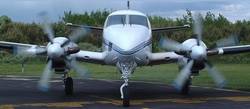Mon, Mar 31, 2003

A proposal to simplify and clarify the way aircraft operations
are classified in Australia has been published by the Civil
Aviation Safety Authority. The Classification of Operations
proposal features three classes of aircraft operations – air
transport, aerial work and general aviation.
The new classifications are put forward in a notice of proposed
rule making issued by CASA this month. Comments on the proposal
close on 12 May 2003.
 Everyone involved in Australian aviation is being
urged to study the new classification of operations policy as it
proposes a different way of classifying how aircraft are used in
the future. Key changes are the abolition of the charter category,
the listing of aerial work activities and the classification of all
operations that are not air transport or aerial work as general
aviation.
Everyone involved in Australian aviation is being
urged to study the new classification of operations policy as it
proposes a different way of classifying how aircraft are used in
the future. Key changes are the abolition of the charter category,
the listing of aerial work activities and the classification of all
operations that are not air transport or aerial work as general
aviation.
CASA’s executive manager Standards, Bill McIntyre, says
the proposals clear up a lot of the uncertainties in the current
classification of operations. “At the moment the definition
of aerial work is unclear and subject to interpretation,” Mr
McIntyre says.
“Under the proposed new rules aerial work operations would
be clearly set out and formally listed. If a flying activity is not
on the aerial work list, then it would not be classified as aerial
work.
“CASA is also proposing to ease the regulatory burden on
aerial work operators by replacing many air operators certificates
with a less onerous and more relevant operating
certificate.”
 The new air transport category would include all
fare-paying passenger-carrying operations, abolishing the separate
classifications for regular public transport and charter flights.
For some charter flights this would mean a lift in some safety
standards – although small operators will naturally not be
expected to meet the same standards as large air transport
carriers.
The new air transport category would include all
fare-paying passenger-carrying operations, abolishing the separate
classifications for regular public transport and charter flights.
For some charter flights this would mean a lift in some safety
standards – although small operators will naturally not be
expected to meet the same standards as large air transport
carriers.
“CASA believes fare paying passengers have the right to
appropriate safety standards, whether the flight is a scheduled
airline service or not. This means some smaller charter operators
would be required to meet higher standards,” Mr McIntyre
says.
More News
From 2023 (YouTube Version): Legacy of a Titan Robert (Bob) Anderson Hoover was a fighter pilot, test pilot, flight instructor, and air show superstar. More so, Bob Hoover was an i>[...]
Get The Latest in Aviation News NOW on Instagram Are you on Instagram yet? It's been around for a few years, quietly picking up traction mostly thanks to everybody's new obsession >[...]
Aero Linx: B-52H Stratofortress The B-52H Stratofortress is a long-range, heavy bomber that can perform a variety of missions. The bomber is capable of flying at high subsonic spee>[...]
Altimeter Setting The barometric pressure reading used to adjust a pressure altimeter for variations in existing atmospheric pressure or to the standard altimeter setting (29.92).>[...]
"Knowing that we play an active part in bettering people's lives is extremely rewarding. My team and I are very thankful for the opportunity to be here and to help in any way we ca>[...]
 Classic Aero-TV: Remembering Bob Hoover
Classic Aero-TV: Remembering Bob Hoover ANN FAQ: Follow Us On Instagram!
ANN FAQ: Follow Us On Instagram! ANN's Daily Aero-Linx (05.15.24)
ANN's Daily Aero-Linx (05.15.24) ANN's Daily Aero-Term (05.15.24):Altimeter Setting
ANN's Daily Aero-Term (05.15.24):Altimeter Setting Aero-News: Quote of the Day (05.16.24)
Aero-News: Quote of the Day (05.16.24)





